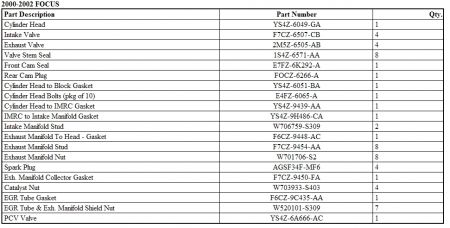The only way to read B and U codes, to test for trouble with modules or data lines is with the right scan tool, Ford knows this and it keeps their service dept. busy, but when you turn the key to the on position does the check engine light come on? This is a built in check of the OBD II system. You have spark, so only three things remain to test, fuel pressure, compression, and the modules. So test what you can, fuel pressure and compression.
https://www.2carpros.com/car_repair_video/test_fuel_injection_pressure.htm
Go here and checkout our video.
And please post which model Focus you drive, se, svt, zts, ztw, zx3, zx5?
There is a Tech bulliten about sticky valves for the 2.0 SPI engine, it goes as follows:
2.0L SPI - ROUGH IDLE, LOW POWER AND/OR STALL AT IDLE WITH DTCS P0300- P0304 TECHNICAL SERVICE BULLETIN Reference Number(s): 04-9-1, Â Date of Issue: Â May 17, 2004 Superceded Bulletin(s): 02-9-1, Â Date of Issue: Â May 13, 2002 Related Ref Number(s): 01-4-13, 02-9-1, 04-9-1 ARTICLE BEGINNING DESCRIPTION DRIVEABILITY - ROUGH IDLE, LOW POWER AND/OR STALL AT IDLE WITH DIAGNOSTIC TROUBLE CODES (DTCS) P0300-P0304 STORED IN MEMORY - VEHICLES EQUIPPED WITH 2.0L SPI ENGINE ONLY ELECTRICAL - MALFUNCTION INDICATOR LAMP (MIL) ILLUMINATED - DIAGNOSTIC TROUBLE CODES (DTCS) P0300-P0304 STORED IN MEMORY - VEHICLES EQUIPPED WITH 2.0L SPI ENGINE ONLY ISSUE Some vehicles equipped with the 2.0L SPI engine may exhibit a malfunction indicator lamp (MIL) illuminated and diagnostic trouble codes (DTCs) P0300 through P0304 stored in memory. The vehicle may also have a rough idle or reduced power condition, and/or may stall at an idle. This may be caused by sticking exhaust valves due to excessive carbon build-up. ACTION Check for faulty fuel injectors and ignition wires. One or more exhaust valves may be temporarily sticking due to carbon build-up between the valve stem and guide. If the diagnostic checks point to a sticking exhaust valve, the cylinder head assembly may need to be replaced with a new level cylinder head assembly with revised valve guides, revised exhaust valves will also need to be installed to help prevent carbon build-up. Refer to the following Service Procedure for details. SERVICE PROCEDURE This condition usually results in misfire when the engine returns to idle after running approximately 2000 RPM or higher. FORD: 1997-2002 ESCORT; 2000-2002 FOCUS MERCURY: 1997-1999 TRACER NOTE: This article supersedes TSB 02-9-1 to update the service and part information. NOTE: THIS PROCEDURE APPLIES ONLY TO THE 2.0L SPI ENGINE.
1. Use the worldwide diagnostic system (WDS) to test for Power Balance with the engine at idle. Check for cylinder misfire. If misfire is occurring constantly, go to Step 3. If misfire is not occurring, attempt to induce misfire by performing the following step: a. Apply the parking brake and keep the transmission in Park or Neutral. Bring the engine to approximately 2800 RPM and hold for one (1) minute. Check the WDS Power Balance display while holding engine speed constant. Allow the engine to return to idle and watch the WDS Power Balance display for a misfiring cylinder. 2. If WDS Power Balance indicates a misfiring cylinder with the previous test, one or more exhaust valves may be intermittently sticking due to carbon build-up between the valve stem and guide. Replace the cylinder head with the new level cylinder head with revised valve guides. Once stock is exhausted of the loaded cylinder heads, the cylinder head will come bare so revised exhaust valves will need to be installed in place of the original valves. The revised valve guides and exhaust valves help prevent carbon build-up. Consult the appropriate model year Workshop Manual for removal and installation procedures for the Cylinder Head Assembly. 3. If WDS Power Balance did not indicate a misfiring cylinder with the previous test or a misfire is occurring constantly, the misfire may not be due to a sticking exhaust valve. Refer to the appropriate model year Powertrain Control/Emissions Diagnosis (PC/ED) Service Manual for further diagnosis. Other possible causes may be, worn or arcing ignition wires, base engine compression, fuel injectors, fuel injector harness resistance or PCM injector driver signal. Perform diagnosis and repair as necessary. 4. After completing either Step 2 or Step 3, replace the PCV Valve (YS4Z-6A666-AC) (Motorcraft EV-244) on model year 2000-2002 Focus or 2000-2002 Escort. Vacuum fluctuations from engine misfire may prematurely wear the PCV valve on those applications. NOTE: THE CYLINDER HEAD ASSEMBLIES LISTED BELOW WILL BE BARE CASTINGS ONCE SUPPLY OF LOADED HEADS IS EXHAUSTED, IN MOST CASES IT WILL BE NECESSARY TO REPLACE ONLY THE PARTS LISTED BELOW, ALL OTHER PARTS CAN BE REUSED.

Friday, June 21st, 2019 AT 1:42 PM
(Merged)




